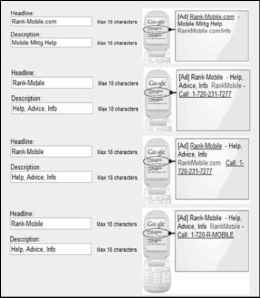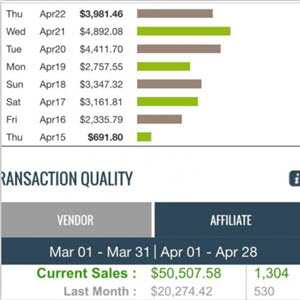Different Types of Mobile Advertising
Mobile advertising can take a lot of different forms, but it is usually consumed when viewers are on the mobile Web, are using mobile applications, or are playing mobile games. When an advertisement is clicked, you generally have the option of driving the click to your website, to a mobile specific landing page, or to a download page. The click might also place a call through the mobile phone. Essentially four types of mobile advertising models are used:
• Mobile banners and display—As with traditional banners, mobile banners are graphics placed on a Web page. After clicking one, the visitor is linked to a specific offer or full-page advertisement. Mobile banners are usually sold on a CPM (cost per thousand impressions) basis. Mobile site owners agree to show the advertisement on their sites in return for payment from the mobile ad network. Mobile display ads can also be included in games and downloadable mobile applications for additional targeted exposure. In the mobile market, a fair average CPM is between $25 and $75, but this varies widely based on the market in which you are working. See Figure 5.1.
Mobile Marketing Consulting o Image
Change this image yos O no_
Mobile Image Specifications view examples
Formats cflfi Mil .grf, jpjj or .png
Jap an-standard sije 192x63 Banner (5k max)
6:1 Aspect Natio 300 x 50 Banner (7,5k max) 216 x 36 Banner (4.6k max) 159x20 Banner (3k max)
4:1 Aspect Ratio
300 x T5 Banner (T.Sk max) 216 x 54 Banner (4.5k max) 168 x42 Banner (3k max)
Select an image from your computer | Ch oose File ] No tile chosen We're unable to recognize your image
Specify the markup language in which your mobile website is written ? Please select the mobile markup language(s) in which your website is written
□ wml (WAP 1,x) E xhtml (WAP 2.0) El chtml (imode, etc.)
□ PDA-compliant html
Figure 5.1 Mobile banner ads.
• Mobile pay per click—Similar to traditional pay-per-click advertising (PPC), mobile PPC ads are text and image advertisements offered by search engines and, usually served alongside organic mobile search results. PPC advertising is displayed when the ad is relevant to the searcher's query. Mobile PPC ads cost the advertiser money only when they are clicked. Advertisers choose a set of keywords that are relevant to searches for their products. Then text ads are served based on an advertiser's bid on a search query and the calculated relevance of the landing page to the search query. In addition to being targeted based on a user's search query, mobile PPC advertising can be targeted by location and carrier.
• Contextual mobile ads—Contextual mobile advertising is similar to mobile PPC. Advertisements are offered by the mobile search engine through a bidding model that combines the advertisers' willingness to pay for position with the relevance of the ad to a search query. Contextual mobile ads can be in the form of text or images, and are displayed on a mobile website instead of in mobile search results. In this model, mobile site owners consent for relevant advertisements to be shown on their websites in return for a portion of the profits that the ad network receives from those particular ads. See Figure 5.2.

- Figure 5.2 Google AdWords mobile text ad options.
• Idle screen advertising—Mobile advertisements are served while the user is waiting on a page or application to download or some other process to finish.
Although ads can be included on any mobile site, mobile advertisements are most commonly included on mobile news and information portals, social networks, and gaming sites. These types of companies invest heavily in the development of their mobile websites, whether they are news portals, social networks, or online game sites. They anticipate that their mobile websites will be generating high amounts of mobile traffic that they can monetize by selling advertising on the website. Frequently, these companies are giving away their mobile content for free, so their only way to make money is to sell advertising.
A BRIEF HISTORY OF MOBILE ADVERTISING
In the year 2000, D2 Communications, a Japanese mobile-marketing company, began delivering mobile banner ads, but most mobile advertising companies in the United States began delivering graphical banner ads only around the year 2005.
In the United States, mobile advertising was first pioneered by mobile carriers on their carrier decks, when they began offering text-based sponsorship on their portals. The ads were sold predominantly by carriers, were usually based on a CPM model, and were sold to companies and brands that had mobile-specific websites. Carriers did not push this type of marketing because they preferred long-standing content syndication agreements and didn't have the technology to deploy, target, and manage large-scale advertising networks.
Around the year 2000, third-party mobile advertising companies such as AdMob, JumpTap Millennial Media, Rhythm NewMedia, Third Screen Media, and Medio began creating ad networks that served mobile text and banner advertisements on third-party sites, in Europe and the United States. As phones became more sophisticated, the medium flipped from being mostly text based to mostly image based; now, in 2009, more than 97% of mobile ads are images.
Continue reading here: OnDeck Versus Off Deck Web Advertising
Was this article helpful?


